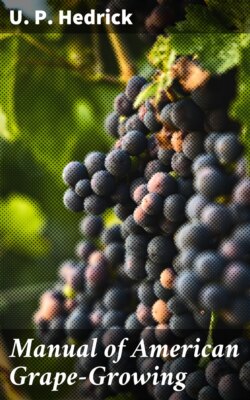Читать книгу Manual of American Grape-Growing - U. P. Hedrick - Страница 106
На сайте Литреса книга снята с продажи.
Tillage methods.
ОглавлениеThere are several reliable guides indicating when the vineyard needs to be tilled. The vineyardist who is but a casual observer of the relation of vineyard operations to the life events and the welfare of his vines will take the crop of weeds as his guide. It is, of course, necessary to keep down the weeds, but the man who waits until weeds force him to till will make a poor showing in his vineyard. The amount of moisture in the soil is a better guide. The chief function of tillage is to save moisture by checking evaporation and to put the soil in such condition that its water-holding capacity is increased. The physical condition of the land is another guide. Tilling when the soil needs pulverizing furnishes a greater feeding surface for the roots.
Tillage begins with plowing in early spring. Whether provided with a cover-crop to be turned under or hard and bare, the land must be broken each spring with the plow. Plowing is best done by running a single furrow with a one-horse plow up to or away from the vines as occasion calls and then following with a two-horse or a gang-plow. Some growers use a disc harrow instead of the plow to break the land in the spring, but this is a doubtful procedure in most vineyards and is impossible when a heavy green-crop covers the land. Tillage with harrow, cultivator, weeder or roller then proceeds at such intervals as conditions demand, seldom less than once a fortnight, until time to sow the cover-crop in midsummer. About the time grapes blossom, the grape-hoe should be used to level down the furrow turned up to the vines in the spring plowing. Tillage should always follow a heavy rain to prevent the formation of a soil crust, this being a time when he who tills quickly tills twice. The number of times a vineyard should be tilled depends on the soil and the season. Ten times over with the cultivator in one vineyard or season may not be as effective as five times in another vineyard or another season. In some regions, as in New York, the grower is so often at the mercy of wet weather in early spring that the plowing is best done in the fall, and spring operations must then open with harrowing with some tool that will break the land thoroughly.
The depth to till is governed by the nature of the soil and the season. Heavy soils need deep tilling; light soils, shallow tilling; in wet weather, till deeply; in dry weather, lightly. Grape roots are well down in the soil and there is little danger of injuring them in deep tillage. The depth of plowing and cultivating should be varied somewhat from season to season to avoid the formation of a plow-sole. In some regions plowing and cultivating may be made a means of combating insects and fungi, and this regulates the depth of tillage. Thus, in the Chautauqua grape-belt of western New York, the pupa of the root-worm, a scourge of the grape in this region, is thrown out and destroyed by the grape-hoe just as it is about ready to emerge as an adult to lay its eggs on the vines. In all regions, leaves and mummied grapes bearing countless myriads of spores of the mildews, black-rot and other fungi are interned by the plow and cannot scatter disease.
The time in the season to stop tillage depends on the locality, the season and the variety. It is a good rule to cease cultivation a few weeks before the grapes attain full size and begin to color, for by this time they will have weighted down the vines so that fruit and foliage will be in the way of the cultivator. In the North, cultivation ceases in the ordinary season about the first of August, earlier the farther south. Rank-growing sorts, as Concord or Clinton, do not need to be cultivated as late as those of smaller growth and scantier foliage, as Delaware or Diamond. The cover-crop seed is covered the last time over with the cultivator. Plate IV shows a well-tilled vineyard of Concords.
